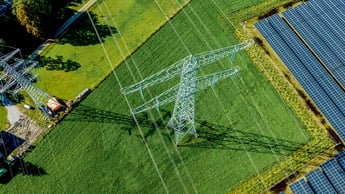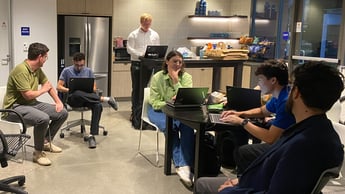Energy transition & our AI solutions to reduce energy consumption
In this article, originally published in the "Financieel Dagblad", Peter Schepers gives his view on the energy transition and we highlight a few of our digital solutions that reduce energy consumption with AI.
The consumer operates "behind the meter," where current energy issues are clearly noticeable; equally noticeable is the pressure of necessary energy transition. But even more can be noticed "in front of the meter": the field of many parties in the energy production chain such as the energy producer, energy supplier, transmission parties, and consumer.
That group is becoming increasingly interesting - because a consumer can often produce as well as consume.
"We increasingly speak of the 'prosumer' says Peter Schepers, CEO of digital engineering firm Itility. "Look at your own solar cells on your roof: you produce for the grid and consume from the grid at different times of the day. This is in fact a decentralization of energy production."
To shape this, all parties in the chain must agree on how to deal with consumption and production. Everyone must contribute to the transition and consider the others. We would like to have prosumers - but we must also agree on when they produce or consume, and how much at a time. In this way, we can optimally utilize the transmission infrastructure.
Schepers continues: "You would preferably like to make such agreements in real-time, because everyone's delivery and consumption patterns vary significantly during the day, but especially the weather is of major influence. For this, you need data, statistics, physics models, and predictions (i.e., artificial intelligence or AI) - you want to make the usage and the control of all those energy flows much more efficient. This energy puzzle is extensive and complex, but we estimate that with AI, an energy efficiency of up to 50% can be achieved.
AI technology is nice, but in our transition projects we particularly see the need for a lot of coordination between clients, companies, and governments. As a consultancy firm, we have consciously decided to regularly take the lead here. And we dive in deep - we have even offered a municipality to write its policy. For us, as a technology provider, this is new, but we all have to contribute our bit. Participating in new partnerships is a must-do.
Reducing energy consumption with artificial intelligence (AI)
With current high energy prices, we will need to look for ways to reduce energy consumption everywhere. At Itility, we consciously invest in digital solutions to achieve actual energy savings.
Energy saving in professional gas ovens
Together with AMF (world leader in production systems for bakeries), we have developed the "Sustainable Oven Service", an AI-driven solution that runs on a physical oven.
How? We monitor the oven with sensors, and enrich this data with differential equations for heat.
Then, the baker inputs his limits for product quality and production quantities. This triggers the so-called AI optimization: a simulation model to optimize the oven. These optimal settings are presented to the baker, who then decides which setting to apply. The baker in control. With the result: a 20% gas saving.
Energy savings at home
The above made us think: can we realize such savings somewhere else? Can we use this at home? The answer turns out to be yes.
Instead of putting the baker in control, we now put the resident in control.
A resident has many elements in the house that determine whether energy comes from the network or from their own solar energy. We can use simulations, similar to the Sustainable Oven Service, to find the optimal balance of energy consumption.
In this case, we have a house with various devices. We collect usage data from each device. We combine this with physics algorithms to create a user-behavior model and a building-consumption model. And with these two models, we simulate scenarios for optimal control based on resident preferences. For example: do I find it OK to charge my electric car during the day, to have my heating between 17 and 22 degrees, to keep my hot water at a certain temperature range?
Optimization runs every 10 minutes to continuously establish the most optimal settings. Initial results: 20 to 40 % efficiency increase of the heat pump.
The article above was published in the "Financieel Dagblad" on December 23, 2022.





